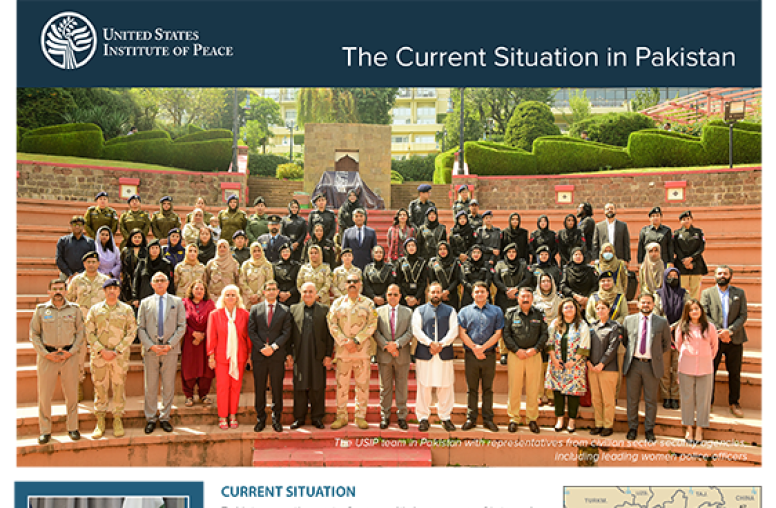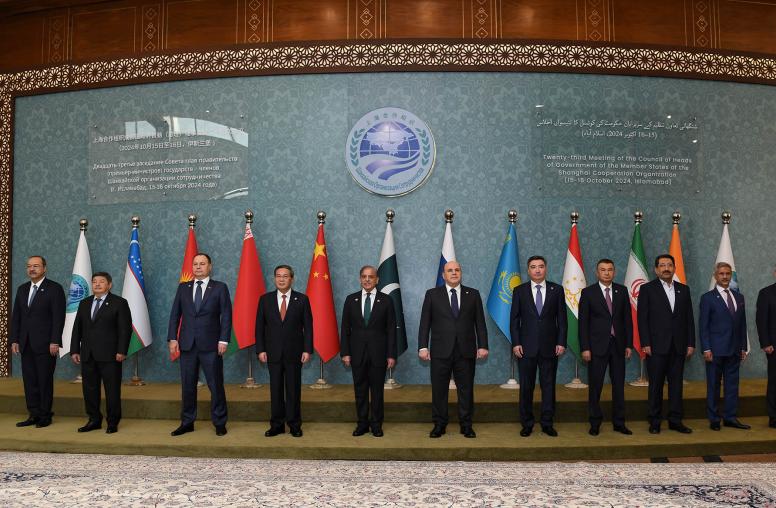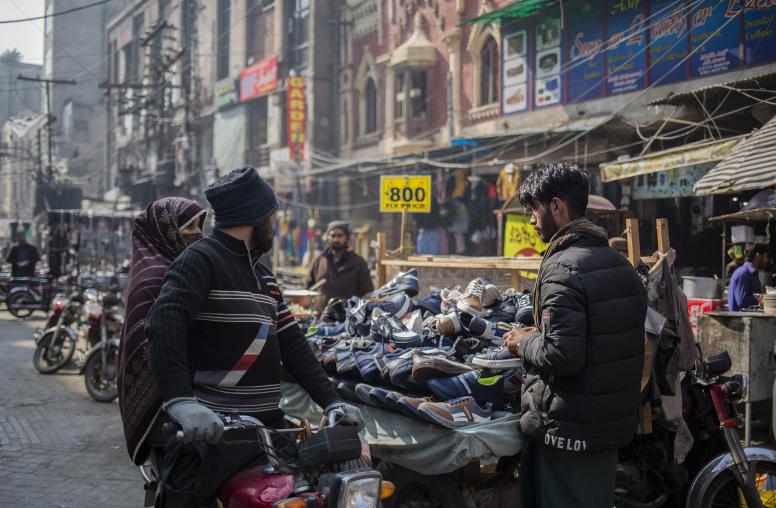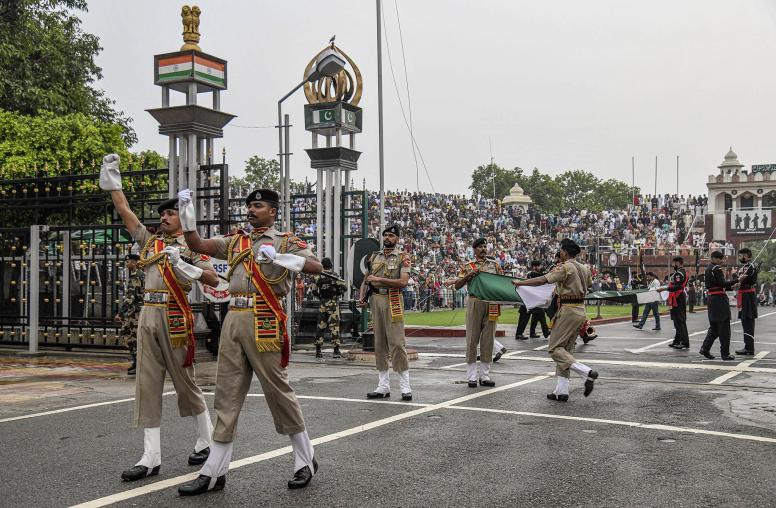Pakistan Faces a Long Road to Sustainable Growth
Weak economic growth and lack of jobs create conditions that are ripe for instability.
At the turn of the century, Pakistan had the highest GDP per capita when compared with India, Bangladesh, and Vietnam. Twenty years later, it is at the bottom of the group. Political upheaval, a violent insurgency fed by the war in Afghanistan, and the inability of successive governments to carry out reforms are to blame for this decline. Today, a polarized political environment and elite intrigue among civilian, judicial, and military institutions has made sustainable economic growth and reforms that much more unlikely. The COVID-19 pandemic has further sharpened the challenge.

Two Years of Crises for Khan
When Pakistani Prime Minister Imran Khan entered office in August 2018, Pakistan’s economy was facing twin deficits—the country’s foreign exchange reserve was running low and its fiscal deficit had reached breaking point. A return to the International Monetary Fund (IMF), along with bilateral support from countries like China and Saudi Arabia, was necessary to stabilize the economy. Within a few months of coming to power, Khan, a charismatic populist who had derided Pakistan’s addiction to debt, famously saying that he would rather commit suicide than beg for money, had to reverse course and seek international help.
The economic upheaval in those early months of Khan’s government led to declining economic growth, devaluation of the currency, double-digit inflation, and sky-high interest rates. The government’s initial attempts to fend off an IMF bailout did not help. Asad Umar resigned from the job of finance minister in April 2019 after losing Khan’s trust. His replacement, the technocrat Abdul Hafeez Sheikh, who also served as finance minister in the Pakistan People’s Party (PPP)-led government from 2010 to 2013, was brought in to negotiate and execute the IMF bailout.
Less than a year later, the COVID-19 pandemic dealt a body blow to Pakistan’s economy. Lockdowns in response to the health crisis turned economic growth negative, a first in decades. The Khan government sought debt relief and secured an additional $1.3 billion from the IMF. The government rolled out a Rs. 1.2 trillion stimulus package. Cash transfer programs were expanded to protect the most vulnerable segments of society. While a significant portion of the total stimulus included already-budgeted spending, and more than Rs. 500 billion remained unutilized, the government’s prompt response eased the pain, particularly for the most vulnerable. Additionally, the State Bank of Pakistan sharply cut interest rates and provided monetary stimulus to businesses.
The biggest relief, however, was provided by the state’s ability to effectively slow down the spread of the coronavirus. Doomsday scenarios did not materialize and despite the political bickering, particularly between Khan’s Pakistan Tehreek-e-Insaf (PTI) party-led federal government and the opposition PPP-led Sindh government, effective cooperation and collaboration through the National Command and Operations Centre flattened the curve, slowing the spread of the coronavirus. As a result, business confidence has returned and economic activity is slowly picking up.
These, however, are only early signs of recovery for an economy that grew by 1.9 percent in 2019 and shrank by 0.4 percent in 2020. While some would like to argue that a V-shaped recovery is taking hold in Pakistan, the reality is that while the economy has stabilized, it has a long and tortuous path toward achieving sustainable growth.
Economy Continues to Face Headwinds
Inflation is still the biggest issue facing the government today. Headline inflation climbed to 9 percent in September 2020 and double-digit food inflation continues to erode citizens’ purchasing power. This has worsened the situation for millions of households who have seen a decline in their purchasing power since 2016, according to data from the Pakistan Bureau of Statistics. In its most recent monetary policy statement, the State Bank of Pakistan raised its concerns as well, warning that while “core inflation has been relatively stable,” food inflation remains a risk, “especially in the wake of recent flood-related damages and potential locust attacks.” With households spending a larger share of their incomes on food—an emerging wheat crisis is compounding problems—consumption spending on other items will remain subdued, leading to a lack of economic growth in a country where consumption spending drives more than 80 percent of the economy.
At the same time, a weak economic recovery around the world, particularly in the European Union and the United States, will subdue demand for Pakistan’s exports. After declining by 20 percent on a year-on-year basis in August, exports grew by 6 percent in September. The outlook, however, remains bleak due to a weak global economic recovery. The issue has been further exacerbated by chronic structural inefficiencies — exporters who received additional orders in recent weeks are facing gas and cotton shortages. This means export growth is unlikely to drive a significant uptick in economic activity and employment. As a result, the structural issue with Pakistan’s economy, i.e., its inability to earn sufficient foreign income to pay for its import and debt servicing needs, remains its Achilles’ heel.
The government has argued that these issues have abated as the economy has run a current account surplus in the last few months. While this surplus most definitely eases balance of payments pressures, the fact is that this decline has been achieved largely due to a drop in machinery imports and energy prices. Additionally, remittance flows have increased, but experts argue that this uptick will be short-lived due to diaspora job losses, particularly in countries like Saudi Arabia and the United Arab Emirates. The State Bank of Pakistan, however, is less pessimistic in its outlook, arguing that Pakistan’s external sector will remain stable during the current fiscal year.
While external sector stability is critical for a country like Pakistan, which is no stranger to balance of payments crises, the fact remains that sustainable growth requires more than a stable current account balance. One measure to better predict the economic outlook is private sector credit growth. If businesses start borrowing more money this would indicate an expanding economy, particularly if the credit is not being used to meet rising inventory costs due to inflation. Data shows that private sector credit remains subdued, with total credit hovering around June 2019 levels. The State Bank of Pakistan is also warning that “the economic recovery remains uneven” and that “growth will recover to slightly over 2 percent” in the current fiscal year. For a country that needs to generate more than 1.3 million jobs a year, an economy that grows at 2 percent a year is no cause for celebration.
Another major issue that continues to plague Pakistan is its yawning fiscal deficit. Despite an uptick in economic activity, tax collection in the first two months of this fiscal year have shown a meager growth of 1.8 percent. The State Bank of Pakistan has been cautious, noting that “risks remain around achieving the revenue target” and “that the pre-pandemic path of fiscal consolidation” is expected to resume soon. This means that the government must keep its spending in check and raise revenue during a period in which real incomes are declining and business activity remains subdued. In this scenario, it is likely that Khan’s finance team decides to continue borrowing at an aggressive rate to plug its fiscal holes and pay for its growing debt servicing, defense, and pension spending needs.
Reforms Are the Only Path Forward
Like in many other parts of the world, Pakistan, too, has become an increasingly polarized country. The government and its supporters are sure to point to a current account surplus and positive growth as evidence that the economy is on the right track. Its critics will point to double-digit food inflation and rising debt as evidence that Khan has failed to deliver.
But beyond the political rhetoric, the fact remains that Pakistan’s economy is hamstrung by the same issues that led to the crisis Khan inherited in 2018. Without meaningful reforms that boost economic competitiveness, direct investment toward productive sectors that promote exports and a sustained effort to end the regulatory quagmire that incentivizes rent-seeking, Pakistan’s economy will continue to grow at an anemic rate.
The journey must begin with energy sector reforms. Burgeoning energy sector debt and market inefficiencies are causing frequent interruptions in electricity and gas supplies to businesses and households. In September, Khan warned of “imminent” gas shortages. No country can grow sustainably and meet its full potential with an energy sector plagued by debt, lack of investments and a growing dependency on imports. The end result is that the economy suffers due to an unreliable and expensive supply of power.
There is broad consensus among economic experts that these reforms need to be pushed through with urgency. However, both civilian and military rulers have failed to usher them in. Successive governments in Pakistan have spent the majority of their term trying to consolidate power, which means that they do not have the will to shake things up. Leaders fear that if they try to change the status quo, then the beneficiaries of the existing rent-seeking economy, both within and outside the government, will weaken their hold on power. As Mosharraf Zaidi argued in a recent article, political leaders in Pakistan “do not have the will or capability to change even the little things to solve the little problems.”
The ultimate goal for Pakistan’s policymakers must be to meet the ambitions and aspirations of its youth. To do that, the country must generate millions of well-paying jobs that expand citizens’ purchasing power. The way things stand, Pakistanis are facing a sustained decline in their purchasing power, chronic power shortages, and a dearth of well-paying jobs. Successive governments’ borrowing has burdened these households with more debt that is being used not to add to the productive capacity of the economy, but to just make ends meet. This is no longer sustainable and without serious reforms, Pakistan risks turning its demographic dividend into a demographic disaster.
Weak economic growth and a lack of jobs create conditions that are ripe for instability. It is, therefore, important for Khan’s government to focus its efforts on restoring growth and setting Pakistan on the path to sustainable economic development.
Uzair Younus is host of the podcast Pakistonomy and a senior fellow at The Atlantic Council.



